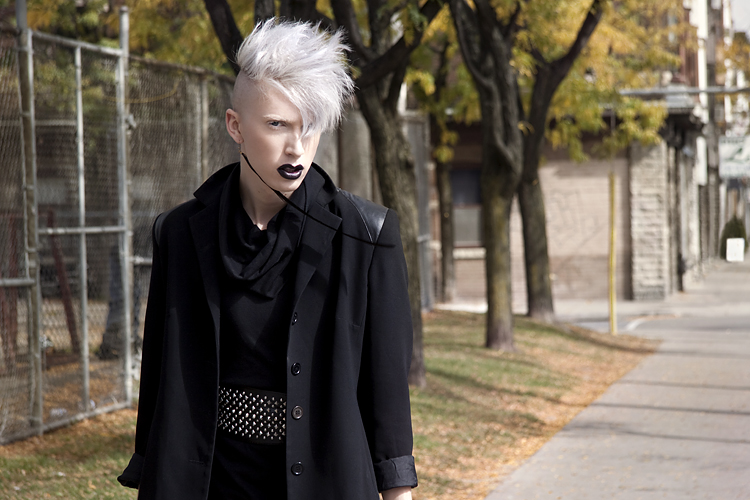A Conversation With Myles Sexton
 |
| The multi-talented Myles Sexton (Photographer: Jonathan Hooper) |
When you go to a party, you never know who you’ll meet, or who you will connect with. We always go out looking for some sort of story or inspiration, but believe me, we never thought we’d come across a young man like Myles Sexton. It was his original design of a feather neck piece that caught our attention amongst the crowd of Toronto’s most fashionable. Being the kind girls were are, we politely asked if we could take a photo of him and his stunning crew. It wasn’t long before we were in conversation.
The tall blonde, decked out in the black feather neck piece, with an androgynous flare, was a model we had seen before, modeling for Adrian Wu last fall. Not only was he a model from Nova Scotia, but he did his own make-up, AND created the feather necklace we fell in love with. That is what we call a story. We exchanged cards that evening in hopes of getting together to talk more. Fast forward a few weeks when we all decide to meet at Toronto’s Dundas Square. Telly and I were early, so being shopaholics, we decided to run into Zara for some browsing when we literally walked into Myles, who was also early. At least we all have good taste right?
We walked to a coffee shop not too far away where Myles was greeted by Stacey McKenzie who happened to be enjoying some java, then we sat down to warm beverages, discussing his career, his androgynous look, pop music, and his leap into the business of accessory fashion design.
 |
|
| I love modeling but, for me, I know there isn’t going to be a constant stream of work forever. – Myles Sexton |
HerCastleGirls: How does a guy in Nova Scotia decide he wants to pursue a full on fashion career?
Myles Sexton:I don’t think it was really a decision. I think one thing led to the next. When I was 15 I got a job at Sobys and I was working as a cashier and up until that point I wanted to be an archaeologist. Every summer I would go away and I would do these digs with my uncle. I was so interested in that aspect. While I was working at Sobys, within the first month, they got rid of the person who would take care of all the magazines, so I said I would take care of it on Fridays, putting out the new magazines and collecting the old ones. One day I came across VOGUE.
I remember taking the magazine home with me and looking through it and seeing all these beautiful women and all these beautiful men, but looking through it, I always saw myself as in-between and I wasn’t seeing anyone who fit my body type or was this sort of androgynous persona. It really inspired me and led me to where I am now. It led me first to pursue modeling thinking, “Why don’t I try to become the man I wished existed?”, so that led me into doing make-up and photography and now its led me to designing so I’m learning and getting different perspectives on the industry.
HCG: That’s really interesting that you started learning different perspectives so early. Most models, in the height of their careers don’t set aside time to learn about other aspects of the fashion business, so we end up with a bunch of retired models who don’t know what to do because they never invested into new paths.
MS: That’s the great thing with Fashion! It’s so stimulating! There is always something going on, so I felt, if I’m going to look at an image as a make-up artist, I’m only going to look at the make-up aspect of the image. If I’m a hair stylist, I’ll only look at the hair styling aspect of the image. Why not gain interest in all aspects and look at the image as a whole? Like, one individual piece. That was a big part of why I wanted to try all these different aspects and see what I could create and what I could do. I definitely don’t think I’m the best at what I do, but if I can learn to do these things I can gain a new perspective on creating.
HCG: Now when you started, like most models, you aren’t really sure of what you can do. How did you make the transition into being more of an editorial model?
MS: I found a modeling agency online. There were only two in Nova Scotia and the one that I found was called Strut, so I set up a self-timer on my camera and I would go to different places in the woods and I would dress up, do my make-up and do all these poses. I sent some of these pictures in with this really long blonde hair. The agency wrote me back and said to pull my hair back and send more pictures, so I did and she then called me in for an interview. She liked my jawline, so once I got signed to the agency, I went through my ‘Tyra Makeover’ and they literally chopped all my hair off.
It was really emotional for me because it [the long hair] was a part of my life. When I was with the agency, she said, ‘You need to be more masculine, you need to project yourself in this way’ and I found it very hard, because it’s not me. I stuck with it for a year and I booked one runway show and that was it. They next year she was getting at me even more and It really started to get to me. I felt I was this creative person and I was being put into this box. We ended up going separate ways. I started freelancing and showing how different I was and that was when I started getting so much work. For two seasons I worked Atlantic Fashion Week (Nova Scotia). Right before I moved to Toronto I booked was a campaign for Human Rights Canada. I moved to Toronto and started to pursue a modelling career even more. I feel Toronto is still growing compared to other cities in the world, it’s still a step ahead from where I was. It’s all about baby steps.
HCG: Androgyny doesn’t work for everybody, so how did you realize it worked for you?
MS: You can make a man look more like a woman and make a woman look more like a man, but it’s that grey area where you’re not pretending to be either or, like playing with a little bit of both. By no means do I think I have the bone structure of Andrej Pejic. I know that I will never be the extreme of Andrej or this hunky guy, so it’s about how I can portray a bit of both, especially with my portfolio, I really tried to do shoots that were specifically one or the other, and then one that’s in the middle. I don’t believe in the stereotypes and labels we have. Sure it makes life a bit easier, maybe, but I don’t think it’s all. It’s amazing to see how trendy its becoming again, and it will be interesting to see where this goes.
 |
| Photographer & Copyright: Billie Chiasson Model/Makeup/Style: Myles Sexton |
HCG: When did the make-up artist career start?
MS: The make-up artistry sort of manifested over the Emo music trend when I was younger. That was my first introduction because I would notice all these boys wearing eyeliner with really porcelain skin and I really loved that image. I would just experiment with make-up. When my mother wasn’t home I’d go through her make-up bag, when she went away to the cottage I would practice on myself. Jeffree Star [model, designer & recording artist] was a person I admired for his loud pink, elaborate make-up. I would just go to Zellers and by little kits and use my imagination to create different characters. I noticed I was getting good at applying make-up so I thought; Why not take this to the next level? So I went to make-up school for a year and while I was in make-up school I got a job at Smashbox cosmetics and I worked with them for 2 years. After a year they invited me to work on their artist team so I got to do Toronto International Film Festival. When I was in make-up school, I didn’t have money to build a portfolio, so with my living expense money I just bought my own camera and started shooting my own portfolio. I think it helps with my perception of things.
HCG: Tell us about your accessory fashion line! What is your process for creating your jewelry? Do you sketch it then make it?
MS: I’m not very good at drawing, but I try to force myself to sketch because I know it’s the proper way, but I just sketch a little basic thing and get to making it. It is an important step tough. When I first put items together it would have saved me some mistakes if I properly drew everything out thoroughly.
HCG: Where do you see yourself with your accessory fashion line five years from now, you think?
MS: I defiantly want to see it sell in Canada, but right now I have buyers in New York that are waiting and want to buy my items. I’m really excited to get it out there. I’d like to branch out from Canada, go to New York and hopefully go to Europe and try the different markets and see how its received, see where my niche is, but I always want to be based here though, because I am Canadian. Like Dsquared, they are Canadian wherever they go, even in Milan.
HCG: Dsquared are very proud Canadians, which is great. Its nice to see Canadians branch out.
MS: We have so much talent in Canada! You look at Greta Constantine and so many more, so you need more people to look at the talent here in this country and focus on what we do that’s different then any other market.
HCG: You seem to be interested in doing so many things! We have to ask, but is a album in the works too?
MS: (Laughs) It’s really funny. When I was younger I actually sat down with a guy and was starting to write music because it just seemed very ‘Jeffree Star’, but we didn’t do anything with it. My mom is a singer but I can’t sing, so that isn’t something I’d do. Maybe acting in fashion films. I could see myself doing that.
We were excited to hear more about Myles new venture, designing an accessory line! He has always used exotic materials to create pieces that work for both men and women. His line is without a name, and is in the planning and creating phase, so to make things more interesting, we will keep mum on the subject, until its fully launched!
Until then, look for Myles online at www.mylessexton.com and become obsessed! He’s one to watch.




